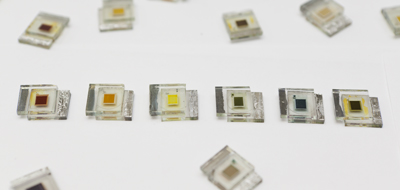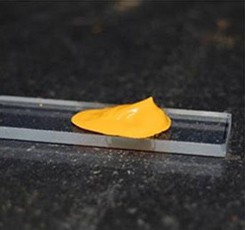Solar Cells
Background
The Clean Energy Demand
The development and industrialization of countries such as China and India is expected to more than double the global energy demand, currently 13TW annually, by 2050. One of the biggest challenges of the near future is to meet this rapidly growing energy demand with clean energy. Greenhouse gas emissions produced by coal, oil, and natural gas contribute to climate changes that are becoming a major concern. The surface temperature of the Atlantic Ocean is higher than it has been in at least a millennium, increasing the likelihood and strength of tropical storms, an increased melting of arctic ice caps, and a higher global surface temperature. It has been predicted that stabilization of atmospheric greenhouse-gas concentrations at a level that would prevent dangerous anthropogenic climate interference with the climate would require 10 TW or carbon-emission-free power by 2050.
To meet this 10 TW challenge, three major options are at our disposal, carbon neutral energy (fossil fuel use in conjunction with carbon capture and sequestration), nuclear power, and renewable energy. To produce 10 TW of carbon neutral energy using fossil fuels 25 billion metric tons of CO2 would need to be sequestered annually (12500km3 or about the volume of Lake Superior!). Using nuclear power to produce 10 TW of clean energy by 2050 would require the construction of a new 1GW nuclear plant somewhere on earth every day until 2050. For these reasons, renewable energy sources promise to be a major part of whatever strategy is taken to meet this 10 TW challenge.
Many different types of renewable energy sources will likely contribute to our future energy production, but each source can only extract a finite amount of power. Hydroelectric resources account for only 0.5 TW possible energy production, capturing energy from all tides and oceans only 2 TW, implementing geothermal energy over all land area, 12 TW, all globally extractable wind power, 2-4 TW, and the solar energy striking the earth, 120,000 TW. While all of these options will likely contribute, only solar energy stands out as the most viable choice to meet our future energy demand. Despite this vast resource, solar energy production remains less than 0.01% of current energy production.
Quantum Dot Solar Cells

Using quantum dot and dye-sensitized solar cells, the color of the solar cell can be tuned to any color of the rainbow.
In an effort to make solar technology economically viable, nanomaterials have emerged as new building blocks for the next generation of solar technology. Semiconductor quantum dots are of specific interest for use in Quantum Dost Sensitized Solar Cells (QDSCs) because of their unique properties. Their size quantization allows one to tune the visible response and vary band offsets to modulate the vectorial charge transfer across different sized particles, they exhibit large intrinsic dipole moments, and open up new possibilities for hot electron capture and multiple exciton generation.
Three configurations, solid state heterojunction, polymer-semiconductor hybrid, and liquid junction quantum dot solar cells, have emerged as viable candidates (Below) for this type of solar cell. All of these types of cells are based on the charge separation at the interface between and excited short bandgap semiconductor and a large bandgap semiconductor or polymer. In the Kamat Lab we seek to use our knowledge of the fundamental science behind light energy conversion to increase the efficiencies and the understanding of the processes involved in all of these types of QDSCs.

Solar cells architectures with semiconductor nanocrystals: (A) semiconductor heterojunction (B) polymer-semiconductor hybrid solar cells (C) liquid junction semiconductor sensitized solar cells.
- Solar Energy - Beyond the Hype - Webinar by Dr. Prashant Kamat on the clean energy challenge and solar energy.
- Build A Dye Solar Cell - Learn how to build a simple dye-sensitized solar cell
- A Delicious Solar Cell - A solar cell made from Doughnuts and Tea by former group member Blake Farrow (Youtube video)
- Measuring Photoelectrochemical Performance - A webinar on the physics and electrochemistry involved in appropriately measuring QDSCs.
References
Meeting the Clean Energy Demand: Nanostructure Architectures for Solar Energy Conversion. Kamat, P. V. J. Phys. Chem. C 2007, 111, 2834-2860. (Feature Article in February 22 2007 issue) NDRL 4697
Quantum Dot Solar Cells. Semiconductor Nanocrystals as Light Harvestors - Centennial Feature Article Kamat, P. V. J. Phys. Chem. B 2008, 113, 18737-18753 . NDRL 4770
436. Quantum Dot Solar Cells. The Next Big Thing in Photovoltaics. Kamat, P. V. J. Phys. Chem. Lett. 2013, 4, 908–918.
Our Research Focus
- Use an understanding of interfacial charge transfer processes in QDSCs to improve efficiencies
- Extend the light absorption of QDSCs further into the infrared portion of the solar spectrum to harvest a greater portion of the incident solar radiation
- Elucidate the role of conducting scaffolds, such as graphene, and their incorporation into photovoltaics as electronic conductors
- Manipulation of the doping of semiconductor nanocrystals using optically active transition metals to utilize long-lived charge carriers
- Develop efficient QDSCs using simple, scalable fabrication techniques such as solution processing
Recent Progress

CdS solar paint developed in the Kamat Lab
- Explored copper iodide as a viable inorganic hole conductor for perovskite solar cells
- Further developed the efficiency and understanding of nanowire solar cells
- Achieved 2% efficiency using thiolated Au clusters, demonstrating the photoactivity of these metal clusters
- Improved the efficiency of CdSeS QDSCs by using the synergistic effects of a tandem-layered architecture
- Fabricated a 1% efficient QDSC using a single step solar paint approach
Select Recent Publications
448. An Inorganic Hole Conductor for Organo-Lead Halide Perovskite Solar Cells. Improved Hole Conductivity with Copper Iodide Christians, J. A.; Fung, R. C. A.; Kamat, P. V. J. Am. Chem. Soc. 2013, ASAP.
446. Sequentially Layered CdSe/CdS Nanowire Architecture for Improved Nanowire Solar Cell Performance Choi, H.; Radich, J. G.; Kamat, P. V. J. Phys. Chem. C 2013, ASAP.
445. CdS Nanowire Solar Cells: Dual Role of Squaraine Dye as a Sensitizer and a Hole Transporter Choi, H.; Kamat, P. V. J. Phys. Chem. Lett. 2013, 4, 3983–3991.
441. Metal-Cluster-Sensitized Solar Cells. A New Class of Thiolated Gold Sensitizers Delivering Efficiency Greater Than 2%. Chen, Y.-S.; Choi, H.; Kamat, P. V. J. Am. Chem. Soc. 2013, 135 (24), pp 8822–8825.
437. CuInS2-Sensitized Quantum Dot Solar Cell. Electrophoretic Deposition, Excited-State Dynamics, and Photovoltaic Performance. Santra, P. K.; Nair, P. V.; Thomas, K. G.; Kamat, P. V. J. Phys. Chem. Lett. 2013, 4, 722–729.
436. Quantum Dot Solar Cells. The Next Big Thing in Photovoltaics. Kamat, P. V. J. Phys. Chem. Lett. 2013, 4, 908–918.
433. Tandem-Layered Quantum Dot Solar Cells: Tuning the Photovoltaic Response with Luminescent Ternary Cadmium Chalcogenides. Santra, P.; Kamat, P. V. J. Am. Chem. Soc. 2013, 135 (2), 877–885.
427. Know Thy Nano Neighbor. Plasmonic versus Electron Charging Effects of Metal Nanoparticles in Dye Sensitized Solar Cells. Choi, H.; Chen, W. T.; Kamat, P. V. ACS Nano 2012, 6 (5), 4418–4427.
423. Synchronized energy and electron transfer processes in covalently linked CdSe-squaraine dye-TiO2 light harvesting assembly. Choi, H.; Santra, P. K.; Kamat, P. V. ACS Nano 2012, 6 (6), 5718–5726.
418. Sun-believable Solar Paint. A Transformative One-Step Approach for Designing Nanocrystalline Solar Cells Genovese, M.; Lightcap, I. V.; Kamat, P. V. ACS Nano 2012, 6 (1), 865–872.
